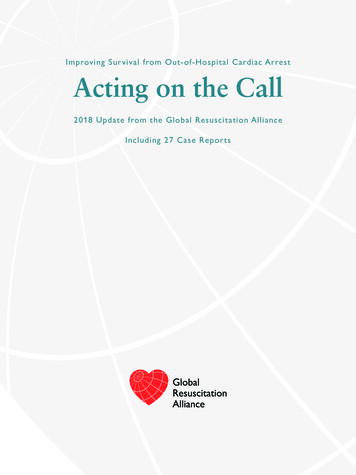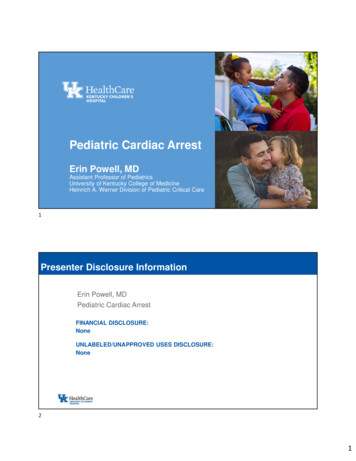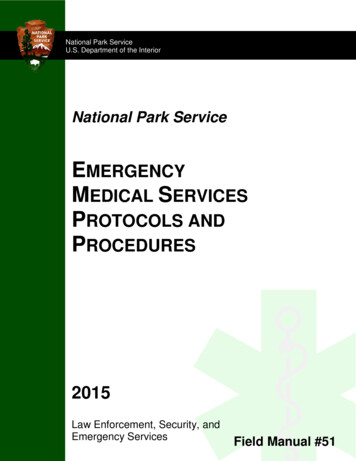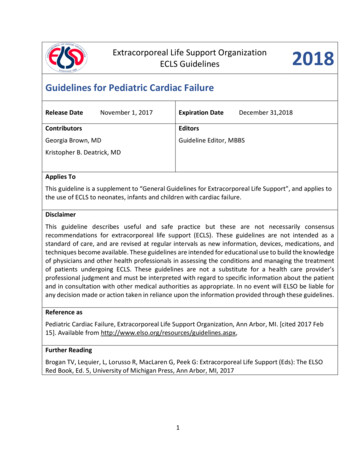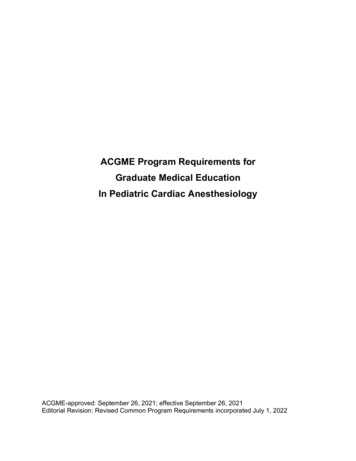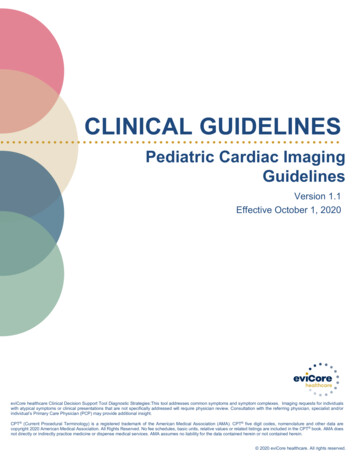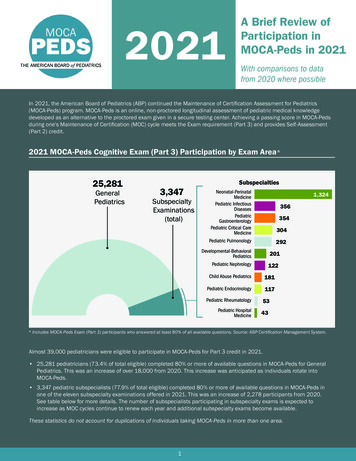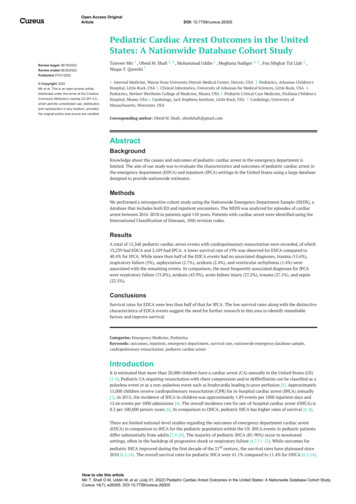
Transcription
Open Access OriginalArticleDOI: 10.7759/cureus.26505Pediatric Cardiac Arrest Outcomes in the UnitedStates: A Nationwide Database Cohort StudyTanveer Mir 1 , Obeid M. Shafi 2, 3 , Mohammad Uddin 1 , Meghana Nadiger 4, 5 , Fnu Sibghat Tul Llah 6 ,Waqas T. Qureshi 7Review began 06/18/2022Review ended 06/29/2022Published 07/01/2022 Copyright 2022Mir et al. This is an open access articledistributed under the terms of the CreativeCommons Attribution License CC-BY 4.0.,which permits unrestricted use, distribution,and reproduction in any medium, providedthe original author and source are credited.1. Internal Medicine, Wayne State University Detroit Medical Center, Detroit, USA 2. Pediatrics, Arkansas Children'sHospital, Little Rock, USA 3. Clinical Informatics, University of Arkansas for Medical Sciences, Little Rock, USA 4.Pediatrics, Herbert Wertheim College of Medicine, Miami, USA 5. Pediatric Critical Care Medicine, Nicklaus Children'sHospital, Miami, USA 6. Cardiology, Jack Stephens Institute, Little Rock, USA 7. Cardiology, University ofMassachusetts, Worcester, USACorresponding author: Obeid M. Shafi, obeidshafi@gmail.comAbstractBackgroundKnowledge about the causes and outcomes of pediatric cardiac arrest in the emergency department islimited. The aim of our study was to evaluate the characteristics and outcomes of pediatric cardiac arrest inthe emergency department (EDCA) and inpatient (IPCA) settings in the United States using a large databasedesigned to provide nationwide estimates.MethodsWe performed a retrospective cohort study using the Nationwide Emergency Department Sample (NEDS), adatabase that includes both ED and inpatient encounters. The NEDS was analyzed for episodes of cardiacarrest between 2016-2018 in patients aged 18 years. Patients with cardiac arrest were identified using theInternational Classification of Diseases, 10th revision codes.ResultsA total of 15,348 pediatric cardiac arrest events with cardiopulmonary resuscitation were recorded, of which13,239 had EDCA and 2,109 had IPCA. A lower survival rate of 19% was observed for EDCA compared to40.4% for IPCA. While more than half of the EDCA events had no associated diagnoses, trauma (15.6%),respiratory failure (5%), asphyxiation (2.7%), acidosis (2.4%), and ventricular arrhythmia (1.4%) wereassociated with the remaining events. In comparison, the most frequently associated diagnoses for IPCAwere respiratory failure (75.8%), acidosis (43.9%), acute kidney injury (27.2%), trauma (27.1%), and sepsis(22.5%).ConclusionsSurvival rates for EDCA were less than half of that for IPCA. The low survival rates along with the distinctivecharacteristics of EDCA events suggest the need for further research in this area to identify remediablefactors and improve survival.Categories: Emergency Medicine, PediatricsKeywords: outcomes, inpatient, emergency department, survival rate, nationwide emergency database sample,cardiopulmonary resuscitation, pediatric cardiac arrestIntroductionIt is estimated that more than 20,000 children have a cardiac arrest (CA) annually in the United States (US)[1-4]. Pediatric CA requiring resuscitation with chest compression and/or defibrillation can be classified as apulseless event or as a non-pulseless event such as bradycardia leading to poor perfusion [5]. Approximately15,000 children receive cardiopulmonary resuscitation (CPR) for in-hospital cardiac arrest (IHCA) annually[1]. In 2015, the incidence of IHCA in children was approximately 1.89 events per 1000 inpatient days and12.66 events per 1000 admissions [4]. The overall incidence rate for out-of-hospital cardiac arrest (OHCA) is8.3 per 100,000 person-years [6]. In comparison to OHCA, pediatric IHCA has higher rates of survival [6-8].There are limited national-level studies regarding the outcomes of emergency department cardiac arrest(EDCA) in comparison to IHCA for the pediatric population within the US. IHCA events in pediatric patientsdiffer substantially from adults [7,9,10]. The majority of pediatric IHCA (85-90%) occur in monitoredsettings, often in the backdrop of progressive shock or respiratory failure [4,7,11-13]. While outcomes forpediatric IHCA improved during the first decade of the 21 st century, the survival rates have plateaued since2010 [4,5,14]. The overall survival rates for pediatric IHCA were 41.1% compared to 11.4% for OHCA [4,5,14].How to cite this articleMir T, Shafi O M, Uddin M, et al. (July 01, 2022) Pediatric Cardiac Arrest Outcomes in the United States: A Nationwide Database Cohort Study.Cureus 14(7): e26505. DOI 10.7759/cureus.26505
Despite higher survival rates of IHCA, more national-level studies are needed to further assess the clinicalcharacteristics and outcomes for CA at different locations within the hospital [14,15]. Worldwide, studies ofpediatric CA in the emergency department (ED) have reported survival rates between 12.8 to 33.8% [16-19].Previously, studies have evaluated the survival of pediatric patients as IHCA and OHCA; however, no studieshave analogized the clinical outcomes of inpatient cardiac arrest (IPCA) and EDCA. Assessing theprevalence, predictors, and causes of pediatric CA based on location within a hospital would allow for abetter understanding of this modifiable disease process to help improve outcomes and healthcare policy.Thus, we evaluated the characteristics and survival rates for pediatric cardiac arrest in the ED and inpatientsettings from the Nationwide Emergency Department Sample (NEDS) database.Materials And MethodsStudy population and inclusion criteriaThis is an observational cohort study of patients with cardiac arrest in the Nationwide EmergencyDepartment Sample (NEDS) database between 2016-2018.The NEDS is the largest all-payer ED database thatis publicly available in the United States and has in-hospital encounters, which include ED encounters andinpatient encounters. Since the database constitutes approximately 20% of the population, a weightedanalysis is recommended to generalize it for the entire population of the US, with unweighted estimatesconsidered invalid [20]. Thus, all NEDS estimates were calculated using national weighted values andaccounted for sample weighting. Using a stratified, random sampling design, a sample of hospital-ownedemergency departments from the US participating in both the State Inpatient Databases (SID) and the StateEmergency Department Databases (SEDD) was selected. One hundred percent of the emergency departmentvisits and inpatient encounters from the selected emergency departments were retained for the studydataset. The SEDD captures information on ED visits that do not result in an admission, while the SIDcontains information on patients initially seen in the emergency and then admitted to the hospital [20].Hospitals were included in the NEDS sample based on geographic region, teaching status (non-teaching orteaching), location (urban or rural), ownership (public, private for-profit, private not-for-profit), and traumacenter designation. A total of 990 emergency departments were included in the NEDS database. From eachselected emergency department, all visits were included, which amounted to more than 33 millionunweighted visits each year. Weighted, the database estimates more than 140 million ED visits and morethan 20 million inpatient admissions per year. The institutional review board declared this study exemptfrom review. However, it was performed according to the ethical criteria set up by Healthcare Cost andUtilization Project (HCUP) [20].Study definitionsCardiac arrest was defined by International Classification of Diseases-10 (ICD-10) codes of I46.2, I46.8,I46.9, I97.121, and I97.11. We excluded patients older than 18 years. We divided patients into EDCA and IPCAbased on the site where CPR was performed. Patients who had a CA in the emergency department (EDCA)were identified with "current procedural terminology codes (CPT)" for cardiopulmonary resuscitation as EDprocedures are added to the database as CPT codes. Patients who had a CA in the inpatient (IPCA) settingwere identified using "procedure codes (PR)" for CPR as the inpatient sample does not have CPT codes(supplemental file, section II). This method has been previously validated and published in the literature[21]. Patient demographics, payer information, and comorbidities were obtained from the database. Theinformation about diagnoses associated with CA was defined by the ICD-10 codes using the links provided inthe appendix.Patient and hospital characteristicsBaseline patient demographic characteristics (age, sex, insurance payer, hospital location) were extractedusing database variables. Diagnostic codes were used to identify comorbidities of hypertension, congenitalheart disease, malignancy, diabetes mellitus, hyperlipidemia, obesity, asthma, epilepsy, sickle cell disease,and renal failure. Since HCUP databases cannot evaluate causation and can only check for an association, weextracted data for variables that have been related as causes and contributing factors by previouslypublished studies, which included asphyxiation and strangulation, cardiac surgery, ventriculartachycardia/fibrillation, shock, acidosis, sepsis, trauma, respiratory failure, hyperkalemia, cerebral edema,pneumonia, cardiomyopathy, hypothermia, bronchiolitis, pneumothorax, acute kidney injury, andpulmonary embolism [7,19,22,23].OutcomesThe primary outcome of the study was survival to discharge. We also studied the characteristics associatedwith CA at different locations.Statistical methodsCategorical variables were expressed as weighted values and percentages. Continuous variables were2022 Mir et al. Cureus 14(7): e26505. DOI 10.7759/cureus.265052 of 8
expressed as mean standard deviation if the variable was not skewed; otherwise, it was expressed as amedian with 25th and 75 th percentiles (interquartile range). Descriptive statistics were performed fordemographics and comorbidities, which were stratified by the type of CA (IPCA and EDCA). We used surveystatistics to calculate Pearson's chi-square test for categorical variables and the t-test for the continuousvariables. We also evaluated the associated diagnoses and provided weighted values along with theirpercentages for the subgroups of patients that had CA in the emergency department and inpatient setting.The proportions were compared using Pearson's chi-square test. All analyses were weighted analyses.Statistical analysis was performed using STATA version 16.1 (College Station, USA). Using STATA 16.1, weconfirmed that there was no overlap in our cohort of patient encounters for those who had a cardiac arrestin the emergency department and those with cardiac arrest in the inpatient setting. All p-values were twosided, with a significance threshold of p 0.05.ResultsA total of 34,763 pediatric CAs were recorded in the NEDS database for the years 2016-2018. Of the 15,348patients (mean age 4.8 6 years, 39.9% females) who had CPR, 13,239 had EDCA, and 2,109 had IPCA (Figure1).FIGURE 1: Graphical abstract of the analysisAKI - acute kidney injury; CHD - congenital heart disease; CPR - cardiopulmonary resuscitation; EDCA emergency department cardiac arrest; IPCA - inpatient cardiac arrest; NEDS - Nationwide EmergencyDepartment SampleImage created with BioRender.com.The mean age of patients with EDCA was 4.5 5.9 years, compared to 6.2 6.2 years for IPCA (p 0.001). Theproportion of males was 60.8% and 56.6% in the ED and inpatient groups (p 0.044), respectively. Thebaseline characteristics for both groups are compared in Table 1. The proportion of patients withcomorbidities of asthma, congenital heart disease, epilepsy, hyperlipidemia, obesity, hypertension,malignancy, and renal failure were all more common in the group with IPCA. Medicaid was the predominantpayer among all CA patients.2022 Mir et al. Cureus 14(7): e26505. DOI 10.7759/cureus.265053 of 8
Variables, n (%)EDCA (n 13,239)IPCA (n 2,109)p-valueMedicare392 (2.9%)79 (3.8%) 0.001Medicaid7,608 (57.5%)1,253 (59.4%) 0.001Private insurance3,270 (24.7%)699 (33.1%) 0.001Self-pay1,969 (14.9%)78 (3.7%) 0.001Teaching hospital7,933 (59.9%)2,053 (97.4%) 0.001Urban location11,969 (90.4%)1,907 (90.5%)0.986Asthma324 (2.5%)215 (10.2%) 0.001Congenital heart disease289 (2.18%)293 (13.9%) 0.001Diabetes mellitus57 (0.4%)30 (1.4%)0.077Epilepsy192 (1.5%)138 (6.5%) 0.001Hyperlipidemia10 (0.06%)18 (0.8%)0.049Hypertension58 (0.4%)231 (11%) 0.001Malignancy23 (0.17%)56 (2.7%)0.002Obesity11 (0.06%)19 (0.9%)0.043Renal failure32 (0.24%)34 (1.6%)0.032Sickle cell disease49 (0.37%)20 (0.9%)0.207Primary payerHospital characteristicsPre-existing conditionsTABLE 1: Baseline characteristics of patients with EDCA and IPCAEDCA - emergency department cardiac arrest; IPCA - inpatient cardiac arrestSurvivalThe overall survival to discharge rate for patients with CA undergoing CPR was 21.9% (n 3,364) during thestudy period. Of the patients who had EDCA, 2,513 (19%) survived post-CPR to discharge. Among IPCApatients, 851 (40.4%) survived post-CPR to discharge.Characteristics associated with cardiac arrestEight thousand eight hundred and four patients with EDCA had no evidently associated diagnosis. Amongthose EDCA patients with an associated diagnosis, trauma was the predominant diagnosis, accounting for15.6% of patients. Others were respiratory failure (5.01%), asphyxiation and strangulation (2.7%), acidosis(2.4%), ventricular arrhythmia (1.4%), hyperkalemia (1.4%), hypothermia (1.2%) and sepsis (1.1%). Incontrast, the most frequently associated factors among IPCA were respiratory failure (75.8%), acidosis(43.9%), acute kidney injury (27.2%), trauma (27.1%), sepsis (22.5%), pneumonia (20.7%), shock (19%),cerebral edema (13.6%), ventricular tachycardia/fibrillation (12.9%), and hyperkalemia (11.1%). Conditionsassociated with EDCA and IPCA are presented in Table 2.2022 Mir et al. Cureus 14(7): e26505. DOI 10.7759/cureus.265054 of 8
Variables, n (%)EDCA (n 13,239)IPCA (n 2,109)p-valueAcidosis320 (2.4%)926 (43.9%) 0.001Acute kidney injury28 (0.21%)573 (27.2%) 0.001Asphyxiation and strangulation357 (2.7%)49 (2.3%)0.606Bronchiolitis17 (0.13%)201 (9.5%) 0.001Cardiac surgery11 (0.07%)52 (2.5%) 0.001Cardiomyopathy22 (0.17%)64 (3%) 0.001Cerebral edema31 (0.23%)287 (13.6%) 0.001Hyperkalemia181 (1.4%)233 (11.1%) 0.001Hypothermia157 (1.2%)43 (2%)0.129Pneumonia106 (0.8%)436 (20.7%) 0.001Pneumothorax104 (0.8%)138 (6.5%) 0.001Pulmonary embolism10 (0.06%)131 (6.2%) 0.001Respiratory failure663 (5.01%)1,598 (75.8%) 0.001Sepsis140 (1.1%)474 (22.5%) 0.001Shock21 (0.2%)393 (19%) 0.001Trauma2,059 (15.6%)571 (27.1%) 0.001Ventricular tachycardia/fibrillation186 (1.4%)272 (12.9%) 0.001TABLE 2: Conditions associated with EDCA and IPCASince cardiac arrest can be multifactorial, the percentages do not add up.EDCA - emergency department cardiac arrest; IPCA - inpatient cardiac arrestDiscussionThis study, based on our literature review, is the first study to have evaluated the different characteristicsand survival rates of pediatric patients who had cardiac arrest based on their location in the ED or inpatientsetting. While previous studies have looked at attributes of OHCA and IHCA, our study explored attributes ofpediatric EDCA and IPCA. The most salient features of our study were: (a) survival was lower for patientswith EDCA, and (b) while more than half of the patients with EDCA did not have another primary diagnosis,trauma was the most frequently observed associated diagnosis in the remaining patients. In contrast,patients with IPCA were commonly observed to have disorders of respiratory failure, acidosis, acute kidneyinjury, sepsis, and shock, in addition to trauma.SurvivalWe observed an overall survival to discharge rate of 21.9%. There was a significant difference in rates ofsurvival based on location, with pediatric IPCA patients (40.4%) having more than twice the survival ratescompared to those with EDCA (19%). Since no previous studies have looked at survival rates for pediatric CAbased on their location like our study, it is difficult to make precise comparisons.The rates of survival to discharge for pediatric patients with CA in the inpatient setting (40.4%) agree closelywith findings reported in the 2020 update from the American Heart Association (AHA) for pediatric IHCA(41.1%) [4]. Other studies have also looked at the trends in the survival rates for pediatric CA. Girotra et al.,in their 2013 study, using the Get With The Guidelines-Resuscitation (GWTG-R) registry, described survivalrates of 14% and 39% for pediatric IHCA in 2000 and 2009, respectively [14]. A more recent study utilizingthe same GWTG-R registry reported rates for survival to discharge of 38% and 66% in 2018 for pediatricIHCA patients with pulseless and non-pulseless CA, respectively [5]. Virani et al., in their 2020 report for theAHA, delineated 41.1 % survival rates for children with IHCA [4]. Although the survival rates have increasedby 0.67% per year on average between 2000 to 2018, there has been a plateau in the increase of survival ratessince 2010, hence the need for continued focus, research, and improvement in this area [5]. Skellett et al.2022 Mir et al. Cureus 14(7): e26505. DOI 10.7759/cureus.265055 of 8
reported an overall survival to discharge rate of 54.2% after pediatric in-hospital cardiac arrest in the UnitedKingdom from their seven-year review of the National Cardiac Arrest Audit (NCAA) database [24].There is a paucity of literature on rates of survival for pediatric patients with EDCA. Michelson et al., in aretrospective study using the NEDS, established a survival rate of 21.7% for pediatric cardiac arrest in the EDfor the years 2009-2014. For non-traumatic CAs, they reported survival rates of 33.8% in the pediatric EDversus 18.9% in the general ED. In their study, the survival rates for traumatic OHCA were 31.7% and 26.1%in pediatric and general EDs, respectively [19]. Our findings of a survival rate of 19% in patients withEDCA are like the overall rate in the study by Michelson et al. (21.7%), where notably, the same NEDSdatabase was utilized [19]. Donoghue et al., utilizing the GWTG-R registry, reported a survival to dischargerate of 20% for pediatric patients with CPR initiated in the ED [17]. Another study reported survival rates of12.8% in children with CA between 2008-2012 using the Korean ED-based clinical registry [16]. A singlecenter, retrospective study from Turkey observed a survival rate of 18% for cardiac arrest in a tertiary-centerpediatric ED over a period of three years [18].The higher survival rates for IPCA compared to EDCA could stem from a myriad of reasons, including earlyrecognition in a monitored setting, greater availability of experienced staff, better preparedness, and knownetiology of CA. The disparate nature of EDCA, where some OHCA events may have been included in theanalysis, could also contribute to lower survival rates for this location in our study.Characteristics associated with cardiac arrestThe causes for cardiac arrest in pediatrics are numerous and include respiratory, traumatic, infectious, andcardiac conditions. Pertinently, pediatric CA is less likely to be a primary cardiac event in comparison toadults [25]. In our study, trauma was recorded as the most associated factor for EDCA events, reported in15.6% of patients. Michelson et al. reported trauma to be associated in around 25% (24.9% to 28.6%) ofpatients with EDCA [19]. Other characteristics associated with this group included respiratory failure,asphyxiation and strangulation, and acidosis. In contrast, pediatric IHCA is often caused by progressiverespiratory insufficiency and/or shock [7,11,12]. The most frequently associated characteristics with IPCA inour study were also respiratory failure, acidosis, acute kidney injury, trauma, sepsis, and shock.Acidosis has been frequently observed in patients with CA and is likely due to a combination of metabolicabnormalities, including increased lactate levels, unmeasured anions, and acute kidney injury, as well asrespiratory insufficiency [26]. Acidosis is an important contributing factor and complication of CA, asacidemia impairs myocardial function and diminishes myocardial response to catecholamines [23,27]. Inaddition, acidosis and sepsis are directly related to each other and worsen the mortality outcomes [28]. Thehigh rates of sepsis and acidosis observed in our study suggest that clinicians should remain vigilant forearly identification and proper management of these likely reversible contributing factors of CA.Interestingly, the EDCA patients had fewer comorbidities than IPCA but higher mortality rates. Since almostone-sixth of EDCA patients had trauma as the associated diagnosis, they could potentially have beenpreviously healthy. This could also suggest that the patients with more comorbidities get triaged quicker toperform a lifesaving intervention, or it could reflect the under-evaluation of patients with EDCA. Thisemphasizes the need to further evaluate the other predictors of EDCA in pediatric patients.Important strengths of this study are the large number of cases on which estimates are based and its nationalrepresentativeness. However, the study also has certain limitations. Since the study is a retrospective,observational study, inference regarding causation should be made with caution. The NEDS database canshow association but can not imply causation or provide temporal event data. Additionally, the NEDSregistry is unable to definitively differentiate in-ED cardiac arrests from OHCA and only includesinformation for inpatients that are admitted through the ED. Also, we relied on reported ICD-10 codes toidentify diagnoses to perform our analysis, which may not accurately reflect the true cause of cardiac arrest.The NEDS is an administrative database that could be subject to inaccurate coding and underreporting ofcomorbid diagnoses. There is an absence of valuable information related to patients' physical examination,electrocardiography, echocardiography, medications, laboratory results, radiologic findings, and long-termcomplications. Also, since the NEDS contains encounter-level records, a single patient may be representedmultiple times in the database for different ED visits. However, the NEDS and the codes used in this studyhave been used in multiple clinical studies and can be considered a reliable database, given the large cohortsanalyzed.ConclusionsIn a nationally representative cohort from the NEDS database, over one-fifth of pediatric cardiac arrestpatients undergoing CPR survived to hospital discharge. The survival for EDCA events was less than half ofthe rates for IPCA events. While trauma was a notably associated diagnosis in both settings, respiratoryfailure, acidosis, acute kidney injury, and sepsis were also commonly associated factors for the inpatientlocation. The low survival rates for EDCA suggest the need for further research to identify remediable factorsand potentially improve survival.2022 Mir et al. Cureus 14(7): e26505. DOI 10.7759/cureus.265056 of 8
AppendicesSupplemental information for identification of ICD codes, andprocedure codesSection ICodes used for generating cardiac arrest files. All codes were ICD-10 codes.I46.2, I46.8, I46.9, I97.121, and I97.11.Section II1) CPT codes used for procedures in the emergency department.Procedure codes for cardiopulmonary resuscitation in the emergency department. (cpt1-cpt15)929502) PR codes used for procedures in the in-patient setting.Procedure codes for cardiopulmonary resuscitation for in-hospital cardiac arrest. (i10 pr ip1-i10 pr ip15)5A12012, 02QA0ZZCodes used for the comorbidities were obtained from the following websites:1) https://www.icd10data.com/2) https://www.icd10data.com/ICD10PCS/Codes3) https://icdcodelookup.com/icd-10/codes4) al InformationDisclosuresHuman subjects: Consent was obtained or waived by all participants in this study. Animal subjects: Allauthors have confirmed that this study did not involve animal subjects or tissue. Conflicts of interest: Incompliance with the ICMJE uniform disclosure form, all authors declare the following: Payment/servicesinfo: All authors have declared that no financial support was received from any organization for thesubmitted work. Financial relationships: All authors have declared that they have no financialrelationships at present or within the previous three years with any organizations that might have aninterest in the submitted work. Other relationships: All authors have declared that there are no otherrelationships or activities that could appear to have influenced the submitted work.AcknowledgementsDrs. Mir and Shafi contributed equally to this work.References1.2.3.4.5.Holmberg MJ, Ross CE, Fitzmaurice G, et al.: Annual incidence of adult and pediatric in-hospital cardiacarrest in the United States. Circ Cardiovasc Qual Outcomes. 2019, 12:e005580.Atkins DL, Everson-Stewart S, Sears GK, Daya M, Osmond MH, Warden CR, Berg RA: Epidemiology andoutcomes from out-of-hospital cardiac arrest in children: the Resuscitation Outcomes Consortium EpistryCardiac Arrest. Circulation. 2009, 119:1484-91. 10.1161/CIRCULATIONAHA.108.802678Knudson JD, Neish SR, Cabrera AG, et al.: Prevalence and outcomes of pediatric in-hospitalcardiopulmonary resuscitation in the United States: an analysis of the Kids' Inpatient Database*. Crit CareMed. 2012, 40:2940-4. 10.1097/CCM.0b013e31825feb3fVirani SS, Alonso A, Benjamin EJ, et al.: Heart disease and stroke statistics-2020 update: a report from theAmerican Heart Association. Circulation. 2020, 141:139-596. 10.1161/CIR.0000000000000757Holmberg MJ, Wiberg S, Ross CE, Kleinman M, Hoeyer-Nielsen AK, Donnino MW, Andersen LW: Trends insurvival after pediatric in-hospital cardiac arrest in the United States. Circulation. 2019, 140:1398-408.10.1161/CIRCULATIONAHA.119.0416672022 Mir et al. Cureus 14(7): e26505. DOI 10.7759/cureus.265057 of 8
24.25.26.27.28.Fink EL, Prince DK, Kaltman JR, et al.: Unchanged pediatric out-of-hospital cardiac arrest incidence andsurvival rates with regional variation in North America. Resuscitation. 2016, n RW, Kirschen MP, Kilbaugh TJ, Sutton RM, Topjian AA: Pediatric in-hospital cardiac arrest andcardiopulmonary resuscitation in the United States: a review. JAMA Pediatr. 2021, 175:293-302.10.1001/jamapediatrics.2020.5039Meert KL, Telford R, Holubkov R, Slomine BS, Christensen JR, Dean JM, Moler FW: Pediatric out-of-hospitalcardiac arrest characteristics and their association with survival and neurobehavioral outcome. Pediatr CritCare Med. 2016, 17:543-50. 10.1097/PCC.0000000000000969Atkins DL, Berger S, Duff JP, et al.: Part 11: pediatric basic life support and cardiopulmonary resuscitationquality. 2015 American Heart Association guidelines update for cardiopulmonary resuscitation andemergency cardiovascular care. Circulation. 2015, 132:519-25. 10.1161/CIR.0000000000000265de Caen AR, Berg MD, Chameides L, et al.: Part 12: pediatric advanced life support. 2015 American HeartAssociation guidelines update for cardiopulmonary resuscitation and emergency cardiovascular care.Circulation. 2015, 132:526-42. 10.1161/CIR.0000000000000266Nadkarni VM, Larkin GL, Peberdy MA, et al.: First documented rhythm and clinical outcome from inhospital cardiac arrest among children and adults. JAMA. 2006, 295:50-7. 10.1001/jama.295.1.50Berg RA, Nadkarni VM, Clark AE, et al.: Incidence and outcomes of cardiopulmonary resuscitation in PICUs .Crit Care Med. 2016, 44:798-808. 10.1097/CCM.0000000000001484Andersen LW, Holmberg MJ, Berg KM, Donnino MW, Granfeldt A: In-hospital cardiac arrest: a review .JAMA. 2019, 321:1200-10. 10.1001/jama.2019.1696Girotra S, Spertus JA, Li Y, Berg RA, Nadkarni VM, Chan PS: Survival trends in pediatric in-hospital cardiacarrests: an analysis from get with the guidelines-resuscitation. Circ Cardiovasc Qual Outcomes. 2013, 6:429. 10.1161/CIRCOUTCOMES.112.967968Matos RI, Watson RS, Nadkarni VM, et al.: Duration of cardiopulmonary resuscitation and illness categoryimpact survival and neurologic outcomes for in-hospital pediatric cardiac arrests. Circulation. 2013,127:442-51. 10.1161/CIRCULATIONAHA.112.125625Ahn JY, Lee MJ, Kim H, Yoon HD, Jang HY: Epidemiological and survival trends of pediatric cardiac arrestsin emergency departments in korea: a cross-sectional, nationwide report. J Korean Med Sci. 2015, 30:135460. 10.3346/jkms.2015.30.9.1354Donoghue AJ, Abella BS, Merchant R, Praestgaard A, Topjian A, Berg R, Nadkarni V: Cardiopulmonaryresuscitation for in-hospital events in the emergency department: a comparison of adult and pediatricoutcomes and care processes. Resuscitation. 2015, 92:94-100. 10.1016/j.resuscitation.2015.04.027Yurtseven A, Turan C, Akarca FK, Saz EU: Pediatric cardiac arrest in the emergency department: outcome isrelated to the time of admission. Pak J Med Sci. 2019, 35:1434-40. 10.12669/pjms.35.5.487Michelson KA, Hudgins JD, Monuteaux MC, Bachur RG, Finkelstein JA: Cardiac arrest survival in pediatricand general emergency departments. Pediatrics. 2018, 141:e20172741. 10.1542/peds.2017-27412018 introduction to the NEDS. Healthcare cost and utilization project (HCUP) . (April 2021). Accessed:September 20, 2021: http://www.hcup-us.ahrq.gov/db/nation/neds/NEDS Introduction 2018.jsp.Mir T, Qureshi WT, Uddin M, Soubani A, Saydain G, Rab T, Kakouros N: Predictors and outcomes of cardiacarrest in the emergency department and in-patient settings in the United States (2016-2018). Resuscitation.2022, 170:100-6. 10.1016/j.resuscitation.2021.11.009Chen N, Callaway CW, Guyette FX, Rittenberger JC, Doshi AA, Dezfulian C, Elmer J: Arrest etiology amongpatients resuscitated from cardiac arrest. Resuscitation. 2018, ochie IK, Bingham R, Eich
The NEDS was analyzed for episodes of cardiac arrest between 2016-2018 in patients aged 18 years. Patients with cardiac arrest were identified using the International Classification of Diseases, 10th revision codes. Results A total of 15,348 pediatric cardiac arrest events with cardiopulmonary resuscitation were recorded, of which
